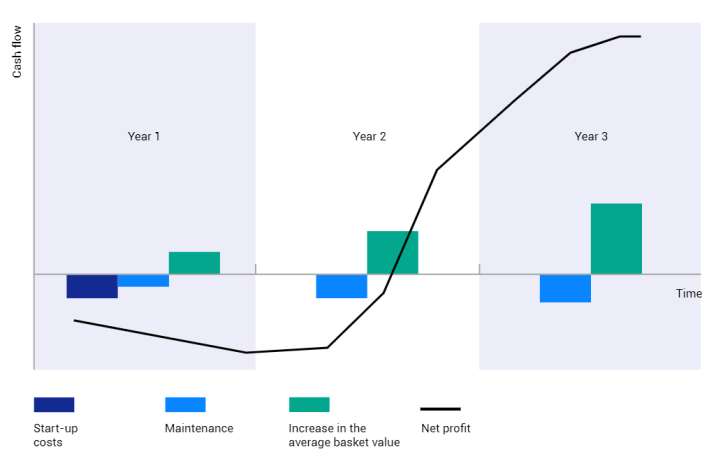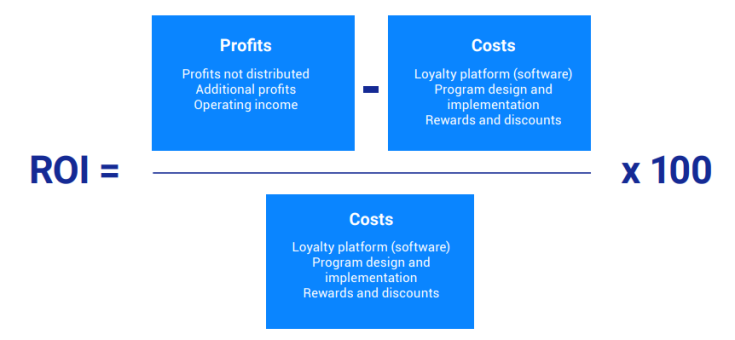From Strategies to Success: Optimizing ROI of Loyalty Programs
- Published
- 6 min reading
Before brands implement a loyalty program, they often grapple with two fundamental questions: “why set up a loyalty program?” and “how much financial value does it contribute?”. The answers to these questions are as diverse as the loyalty programs themselves. While participating in a loyalty program does increase consumer inclination to visit a store or recommend a brand, measuring its impact can be challenging.
Defining ROI in Loyalty Programs
A prevalent misconception is that loyalty programs are cost centers; however, the reality is quite the opposite. With proper strategy and a commitment to innovation, loyalty programs can swiftly evolve into profit centers.
What is ROI?
Return on investment (ROI) estimates how profitable your actions are relative to your initial cost.
Besides the classic financial return on investment, it’s essential to consider the broader spectrum of benefits contributing to overall ROI. Your loyalty program can generate various types of benefits.
Financial Returns on Investment
Traditionally, ROI discussions revolve around the financial benefits of an investment. These benefits are quantifiable and include enhanced customer value, measured through metrics such as order value, visit frequency, and expenditure, comparing the value of savings between members and non-members of the program.
Benefits Associated with Consumer Retention
Similar to financial benefits, these advantages are quantifiable. They encompass “captive” revenue linked to increased customer loyalty, resulting in reduced attrition and inactivity among members.
According to a study by Bain & Company, reducing customer attrition by 5% increases profits by 25-95%. According to the same study by Comarch, loyalty programs reduce customer attrition by 4-7%.
Operational Benefits
The loyalty programs also yield advantages in other aspects of the company. They enhance advertising effectiveness and brand promotion, with marketing activities targeting loyalty program members exhibiting up to a 40% higher conversion rate. Additionally, loyalty programs facilitate the collection of zero-party data, which is valuable across various organizational functions, especially considering tightening data collection regulations.
Based on data from these 3 categories, it’s evident that a well-executed loyalty program generates more benefits than costs. Comarch estimates that 93.1% of companies achieve positive ROI.

3 Stages of Predicting the True Value of a Loyalty Program
- Evaluate the improvement in the quality of the customer relationship.
- Retention: Is your customer still there?
- Engagement: Does your customer visit your store more frequently?
- Recommendation: Does your customer recommend you to the market?
- Assess the effectiveness of the program.
- Monitor membership, point issue, and point redemption statistics.
- Follow headline KPIs, such as loyalty revenue, average loyalty basket, and points issued.
- Develop a comprehensive view of financial performance. Integrate different monitoring elements, such as:
- Gross margin on revenue increase through loyalty.
- Increase in average basket value of member customers.
- Increase in purchase frequency of member customers.
- Coverage of your program (number of customers).
- Cost of loyalty (solutions + rewards).
Remember to set specific hypotheses such as average basket value, program penetration, and estimated total cost of the program. Experts from Comarch can help you establish them, considering trends and your industry's specificity.
Calculate the ROI of Loyalty Programs

A favorable, greater than 1 ratio indicates that your loyalty program generates more profit than costs.
5 Strategies for Maximizing ROI
- Utilize Unique Customer Profiles: Leverage customer profiles to tailor specials and rewards based on individual habits and preferences, enhancing engagement and satisfaction.
- Harness the "Home Stretch Effect" of Rewards: Capitalize on the psychological tendency of customers to spend more when nearing a reward threshold. This tactic not only boosts immediate revenue but also fosters long-term loyalty.
- Reward Most Valuable Customers: Recognize and incentivize the top tier of your customer base, as they often contribute a significant portion of your revenue. Offering exclusive perks and VIP incentives reinforces their loyalty and encourages continued patronage.
- Implement Winback Campaigns: Deploy data-driven winback campaigns to re-engage customers at risk of churn. By targeting inactive or disengaged customers with personalized offers or incentives, you can reignite their interest and generate additional ROI.
- Foster Customer Feedback: Solicit and act upon customer feedback to demonstrate your commitment to improving their experience. Not only does this show genuine care for their satisfaction, but it also provides invaluable insights for refining and optimizing your loyalty program for maximum effectiveness.
Maximizing Value Through Effective Monitoring
The best practices for monitoring a loyalty program and deriving maximum value from it involve several key steps:
- Comparing the behavior of loyal customers with that of non-members.
- Regularly measuring specific metrics.
- Meticulously tracking profits and losses.
Loyalty program metrics serve as valuable indicators for forecasting potential profits. Once implemented, analyzing profit information and cost data treats loyalty management like managing any production entity, typically resulting in positive returns within three years. Insights gained from loyalty data can guide core business decisions, with even basic data aiding in the construction of complex analyses.
Effective data collection and analysis are paramount, especially with stringent legislation like GDPR and the waning use of cookies. Drawing inspiration from successful programs and industry trends can significantly enhance both customer experience and program effectiveness.
In conclusion, strategically designed and executed loyalty programs bolster customer loyalty and yield substantial financial and operational benefits. Businesses can ensure sustainable profitability and long-term success by consistently monitoring and optimizing loyalty initiatives.
Go the Extra Mile: Download the ROI e-Book
Are you eager to dive deeper? Discover expert insights on maximizing the return on investment of your loyalty program by downloading our comprehensive e-book.
Click here to download the E-Book
Authored by our team at Comarch, in collaboration with seasoned loyalty professionals from Velvet, Bartle, Auchan Retail, and more, this e-book delves into specific customer loyalty KPIs and metrics to track. Explore real-life examples and statistics from Comarch’s studies to gain actionable tips and elevate your loyalty strategy today.






